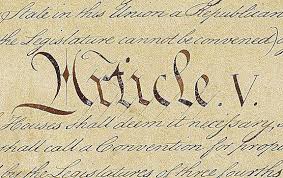“The Congress . . . shall call a Convention for proposing Amendments, which, in either Case, shall be valid . . . when ratified by the Legislatures of three fourths of the several States, or by Conventions in three fourths thereof . . . ” U.S. Constitution, Article V
“The Ratification of the Conventions of nine States, shall be sufficient for the Establishment of this Constitution between the States so ratifying the Same.” U.S. Constitution, Article VII
The late Phyllis Schlafly, when opposing a convention for proposing amendments, repeatedly likened it to the Republican and Democratic National Conventions. The idea, apparently, was to conjure up images of the chaotic mob scenes we have seen on television.
By so doing, Schlafly committed the common fallacy of anachronism: reading into history or a historical text the meanings and values of another time. The most common kind of anachronism is transferring a modern notion into a time or text when things were quite different—as if a scriptwriter for an old Western movie had John Wayne check his smart phone.
Anachronism can lead to grotesque distortion of the truth: In fact, a convention for proposing amendments is almost as different from a national party convention as the eye of a person is from the eye of a hurricane.
The Constitution uses the term convention three times. It appears twice in Article V and once in Article VII (the ratification provision). The “convention for proposing amendments” refers to an interstate gathering. The other two are assemblies within individual states.
We know from prior and subsequent practice how these conventions are chosen. The in-state gatherings consist of delegates directly elected by the people in pre-set geographical districts. The interstate gathering is a diplomatic gathering of representatives of the state legislatures of the kind called a “convention of the states.”
Schlafly did her best to deny that a convention for proposing amendments is a “convention of the states.” But the evidence is both uncontradicted and overwhelming, and has been confirmed by the U.S. Supreme Court. Myths to the contrary were promoted by a disinformation campaign fostered in academic literature and the press during the 1960s, ‘70s, and ‘80s by establishment liberals who opposed amendments to reduce federal power.
Prior to and during the Founding Era, Americans struggled with what to call ad hoc meetings of these kinds. They were not legislatures, because they were temporary and selected outside the usual legislative procedures. So Americans dubbed them with three different words: congress, committee, and convention.
Congress derives from Latin. It means “a walking together.” Before 1775, it referred to a diplomatic meeting of delegations from different governments. Thus, it was a natural term for a conclave among colonies or states. There was a 1754 Albany Congress, a 1765 Stamp Act Congress, the First Continental Congress (1774), and so forth. New York created a “provincial congress” that administered affairs after the colonial legislature was disbanded and until Independence was declared. The name congress reflected the fact that delegates were elected by towns or counties.
Beginning in 1775 the Second Continental Congress became a quasi-permanent legislative body. In 1781 it was succeeded by the Confederation Congress and in 1789 by the Federal Congress. Application of “congress” to the federal legislature discouraged people from applying it to other assemblies.
A small convention of states sometimes was called a committee. (This term, also, is Latin: the verb committere means to commit to, entrust to.) Further, the word could mean a delegation sent to a convention of states. But these “committees” were easy to confuse with committees within other assemblies, as in “the convention’s rules committee” or “the ways and means committee of the legislature.”
Convention (from the Latin convenire, to come together) originally signified only a meeting. However, “convention” became the name of a policy-making body in Scottish Presbyterian practice, and during the constitutional crises of 1660 and 1689 the English called their emergency assemblies “Convention Parliaments.” In the latter year, Americans began to apply the word to temporary “congresses” and to emergency assemblies.
Thus, throughout much of the 18th century, Americans might call the same kind of gathering by several different words. After Independence was declared but before election of the state legislature under the new state constitution, New York was governed by a “Convention of Representatives.” Beginning in January, 1788, the state convention consisted of members of the new state legislature, which had not yet been formally convened.
To add to the confusion, the identical assembly might be referred to by several names. The records of the New York Provincial Congress show it addressing the Continental Congress as the “continental convention” and the Continental Congress addressing the Provincial Congress as the “provincial convention.”
Fortunately, by the time the Constitution was written, this verbal confusion had been pretty much sorted out. Temporary in-state conclaves increasingly were called conventions. Interstate meetings were nearly always called “conventions” rather than committees or congresses.
That’s why the framers selected the word “convention” rather than some other term for insertion in Articles V and VII.








